What are Spanish ER verbs?
ER verbs in Spanish are verbs which end in ER in the infinitive form, such as comer (to eat), aprender (to learn), comprender (to understand), beber (to drink), saber (to know) and querer (to want). This post will cover both regular and irregular Spansih ER verb conjugations in detail.

Regular vs. irregular Spanish ER verb conjugations
The Spanish languages classifies verbs into three groups, AR verbs, IR verbs and ER verbs. Specifically, these are the letters of the verbs in their infinitive forms.
When a verb is classified as a “regular ER verb”, this means that in addition to ending in ER in the infinitive form, its endings are the same as all other regular ER verbs.
However, while an “irregular ER verb” will still end in ER in the infinitive form, its endings when conjugated will differ from regular ER verbs.
The graphic below illustrates this point.

Spanish regular ER verbs
The following are regular Spanish ER verbs. This means that the endings of these verbs all follow the same pattern: o, es, e, emos, éis and en. This also means that there no changes in stem patterns.
Comer to eat

Example sentences:
- Yo como el chicharrón. I eat the pork rind.
- Tu comes el ceviche. You eat the ceviche.
- Nosotros comimos en su casa. We ate in your house.
- Ellos comieron en un restaurante. They ate in a restaurant.
Aprender to learn

Example sentences:
- Yo aprendo español. I learn French.
- Él aprende a conducir. He learns how to drive.
- ¿Cuándo aprendiste esta idioma? When did you learn this language?
- Yo pienso qui aprendieron rápidamente. I think they learned fast.
Comprender to understand
Comprender means “to understand” and is essential the same pas the previous aprender with a com prefix.

Example sentences:
- Yo comprender esta palabra. I understand this word.
- Tú comprendes la frase? Do you understand the sentence?
- Ellos no comprenderieron las instrucciones. They didn’t understand the directions.
- Usted comprendió todo el discurso. You understood the entire speech.
Beber to drink

Example sentences:
- Yo bebo el jugo de naranja. I drink the orange juice.
- Tu bebes la tequila. You drink the tequila.
- Nostros bebimos el vino tinto. We drank the red wine.
- Usted bebió un refresco. You drank a soft drink.
Vender to sell

Example sentences:
- Yo vendo el coche. I sell the car.
- Tu vendes la casa. You sell the house.
- ¿Por qué vendiste la moto? Why did you sell the motorbike?
- ¿Vendieron la casa? Did they sell the house?
Responder to answer, reply
Responder means “to answer” or “to reply”. The verb contestar also has the same meaning. We’ve included contestar on our Spanish AR verbs page.

Example sentences:
- Yo respondo a sus preguntas. I answer you questions.
- Tu respondes al teléphono. You answer the phone.
- Usted no respondió a mi pregunta. You didn’t answer my question.
- Ellos responderieron la llamada. The answered the call.
Irregular ER verbs
Many Spanish verbs end in ER in the present tense but are considered irregular because they have a change in either the stem, the ending or both.
The following verbs are classified as irregular ER verbs because they have a stem change in the first person singular (yo) form.
Hacer to make, to do

Example sentences:
- Yo hago mi tarea. I’m doing my homework.
- El pastelero hace el pastel. The baker makes the cake.
- Tú hiciste tu cama. You made your bed.
- Ustedes hicieron la cena. You made dinner.
Poner to put

Example sentences:
- Yo pongo la mesa. I set the table.
- Tú pones los cubiertos en la mesa. You put the silverware on the table.
- Usted puco los libros en los estantes. You put the books on the shelves.
- Ustedes pucieron roba limpia. You put on clean clothes.
Saber to know

Example sentences:
- Yo sé la verdad. I know the truth.
- ¿Tú dónde está Miguel? Do you know where Miguel is?
- ¿Cómo supiste la respuesta? How did you know the answer?
- Ellos supieron lo que pasó. They knew what happened.
Traer to bring
Translations of verb traer include “to bring” and “to wear”.
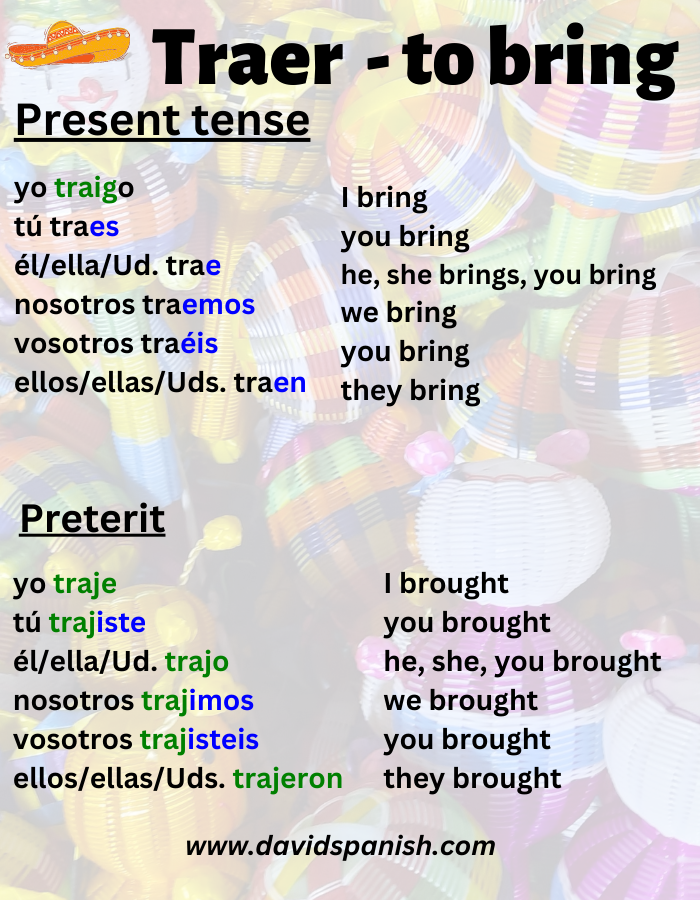
Example sentences:
- Yo traigo mi perro. I‘m bringing my dog.
- Tu traes tu esposa. You’re bringing you wife.
- Usted trajo el café. You brought the coffee.
- Ellos trajeron pantalones. They wore pants.
Coger to catch, grab
For verbs ending in -ger, the -g becomes a -j in the first-person singular (yo) form.
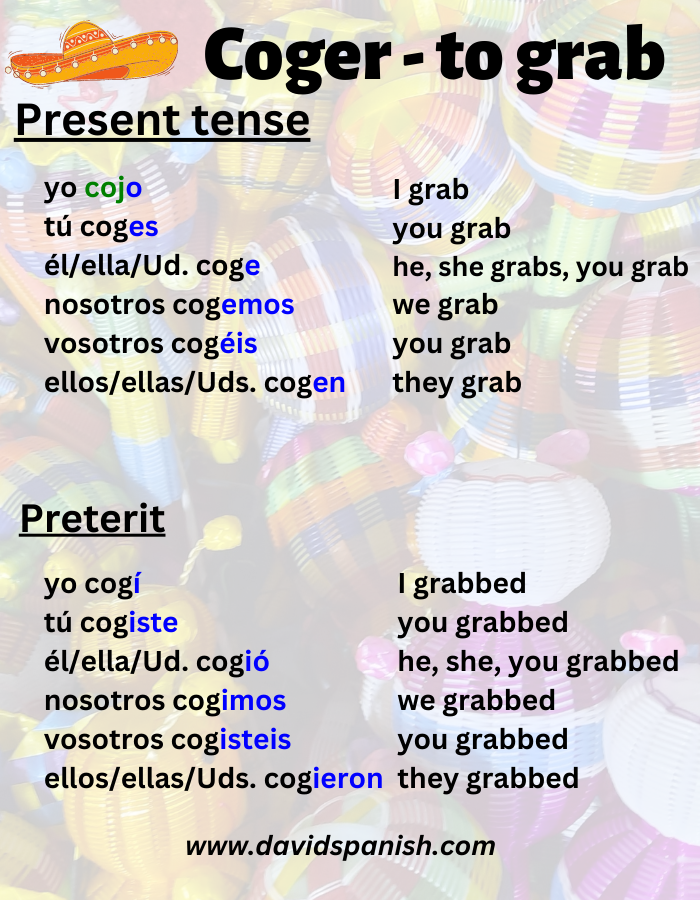
Example sentences:
- Yo cojo la pelota. I grab the ball.
- La policía coge al ladron. The police catches the criminal.
Verbs which follow the same pattern of coger include:
- encoger to shrink
- escoger to choose
- proteger to protect
- recoger to pick up
Ver to see

Example sentences:
- Yo veo la montaña. I see the mountain.
- Ella ve el coche. She sees the car.
- Nosotros vimos la pelicula. We saw the movie.
- Ellos vieron la serie de televisión. They saw the TV series.
Conocer to know (a person, place)
For verbs ending in -cer in the infinitive, the -c becomes a -zc in the first-person singular (yo) form. Conocer also means “to know” and is used for people, places and areas of study.

Example sentences:
- Conozco a tu madre. I know your mother.
- María conoce a Pablo. María knows Pablo.
- Conocen bien la historia de este país. They know the history of this country well.
- Dónde conociste tu esposa? Where did you meet your wife.
Verbs which follow the same conjugation pattern as conocer (to know) include:
- agredecer to thank
- aparecer to appear
- complacer to please
- establecer to establish
- merecer to deserve
- ofrecer to offer
- permanecer to remain
- pertenecer to belong
- reconocer to recognize
Ser to be
The verb ser (to be) is irregular in both its stem and endings.
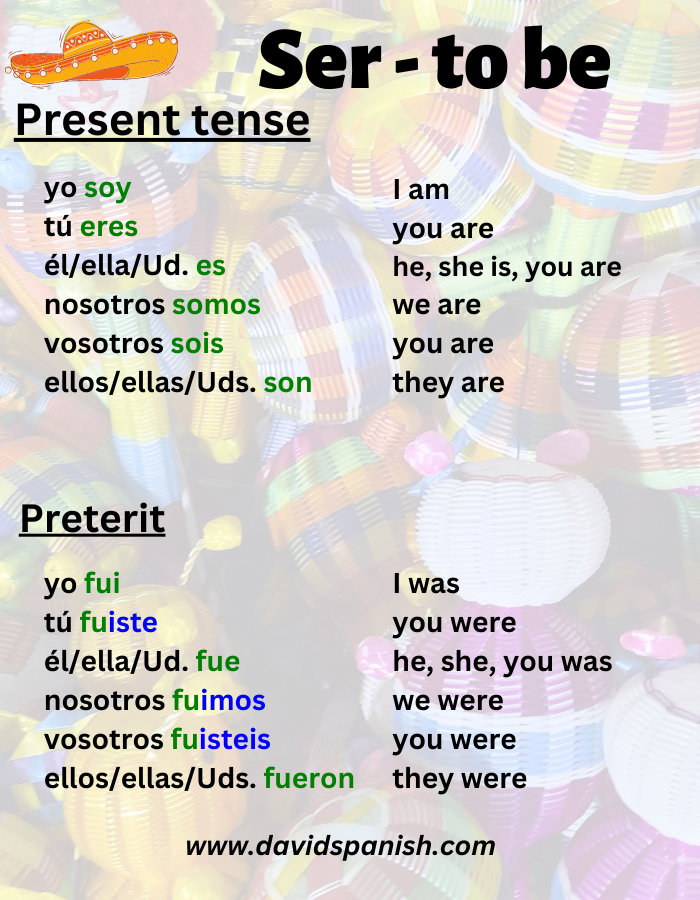
Example sentences:
- Yo soy mexicano. I’m Mexican.
- Tu eres colombiano. You are Columbian.
- Nosotros fuimos estudiantes. We were students.
- Ellos fueron buenos amigos. They were good friends.
Tener to have
The verb tener (to have) also both irregular its stem and endings.

Example sentences:
- Yo tengo un perro. I have a dog.
- Tu tienes veinte años. You are twenty years-old.
- Nosotros tuvimos una casa en Chile. We had a house in Chile.
- Ellos tuvieron un gato. They had a cat.
Verbs which follow the same conjugation pattern as tener include:
- contener to contain
- detener to detain
- mantener to maintain
- obener to obtain
- retener to retain
- sostenir to sustain
Convencer to convince
For verbs ending in -cer in the infinitive, the -c becomes a -z in the first-person singular (yo) form. Verbs following the same pattern as convencer include ejercer (to practice a profession) and vencer (to overcome).
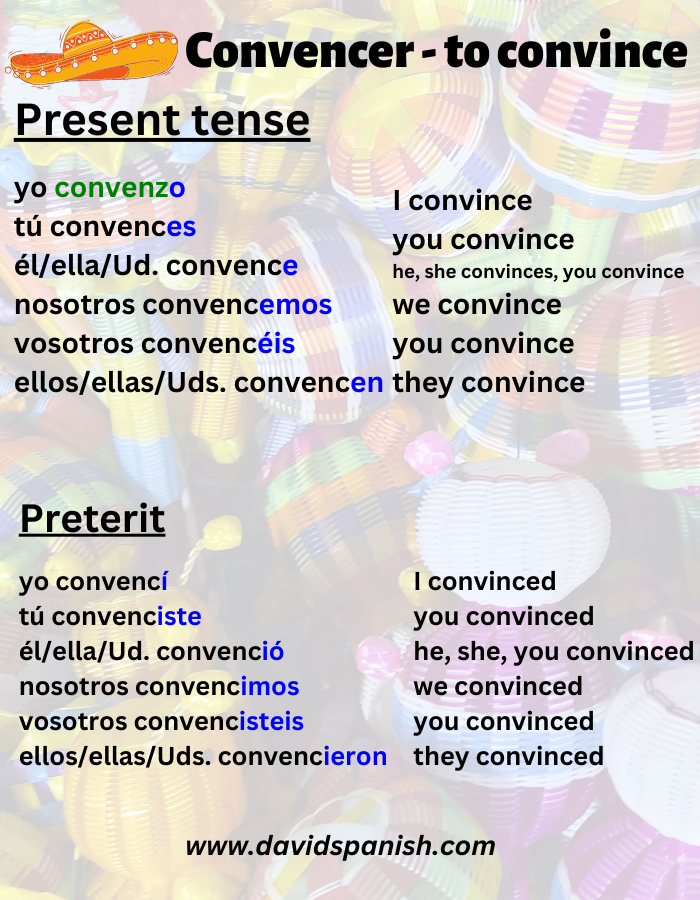
Stem change: e->ie
Querer to want, to love
For the verb querer (to want), the -e becomes an -ie in the yo, tú, el/ella/usted, ellos/ellas forms. The verb querer also translates to “to love”.
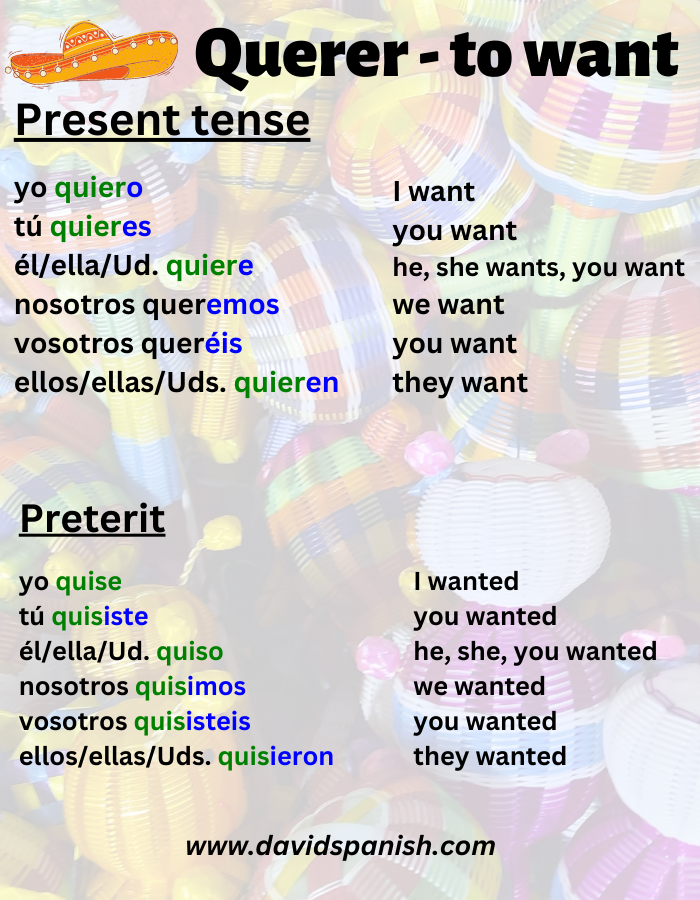
Example sentences:
- Yo quiero comprar un nuevo coche. I want to buy a new car.
- Qué quieres hacer esta noche? What do you want to do tonight?
- Los niños quieren a sus padres. The kids love their parents.
Perder to lose
The verb perder (to lose) follows the same pattern.

Example sentences:
- Yo pierdo la paciencia. I lose patience.
- El perdío el libro. He lost the book.
- Tu perdiste la llaves. You lost your keys.
Stem change: o -> ue
Poder (can, to be able)
For the verb poder, the -o becomes -ue in the yo, tú, el/ella/usted, ellos/ellas forms.

Example sentences:
- Yo puedo ayudarte. I can help you.
- Ella puede venir mañana. She can come tomorrow.
Volver to return
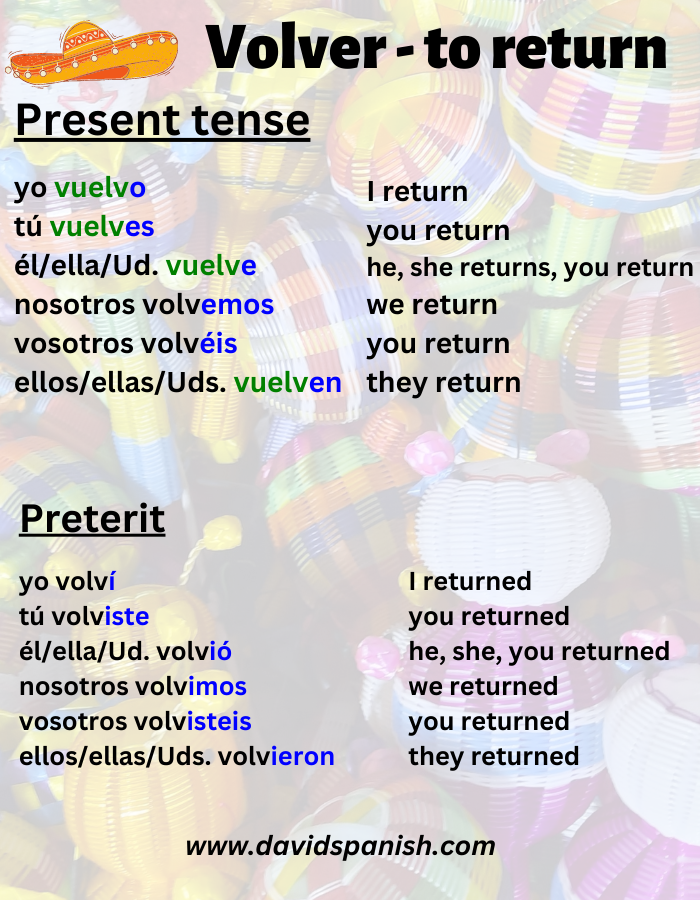
Example sentences:
- Yo vuelvo a casa. I come home.
- Yo volví a estudiar español. I started studying Spanish again.
The verbs resolver (to solve) and revolver (to stir) follow the same pattern.
Discover more:
- La Bamba Meaning, Spanish Lyrics & English Translation - May 4, 2024
- Bésame Mucho Meaning, Spanish Lyrics & English Translation - May 3, 2024
- Querida – Lyrics, Meaning & Translation - May 2, 2024
